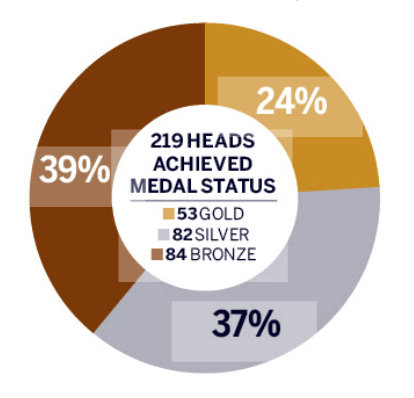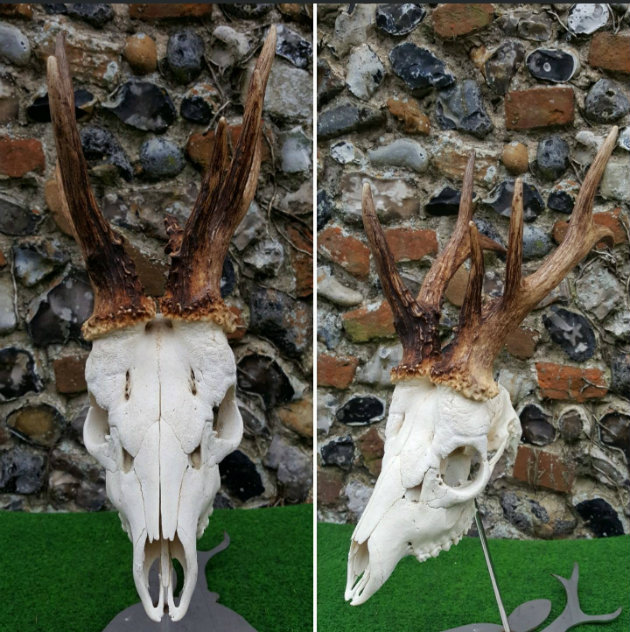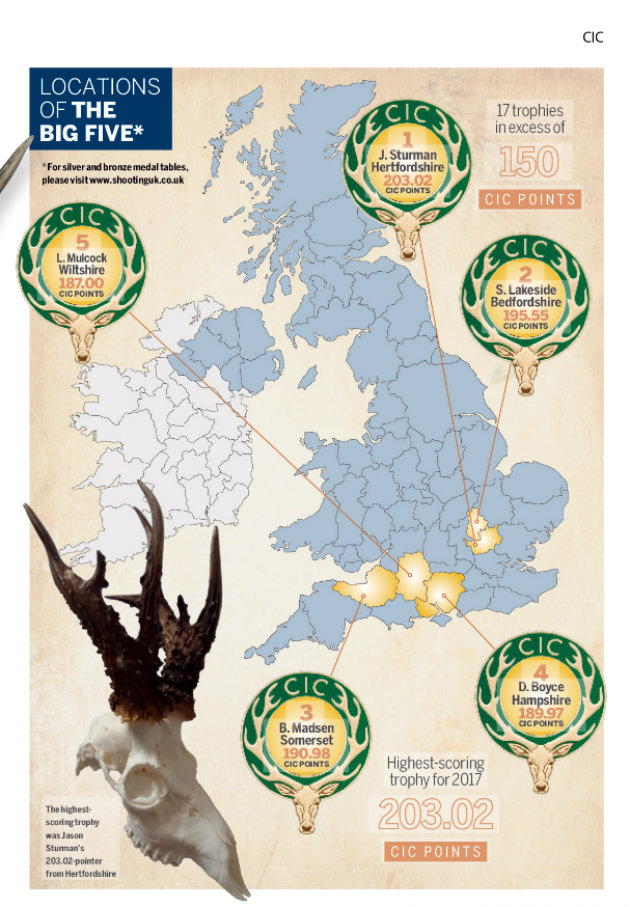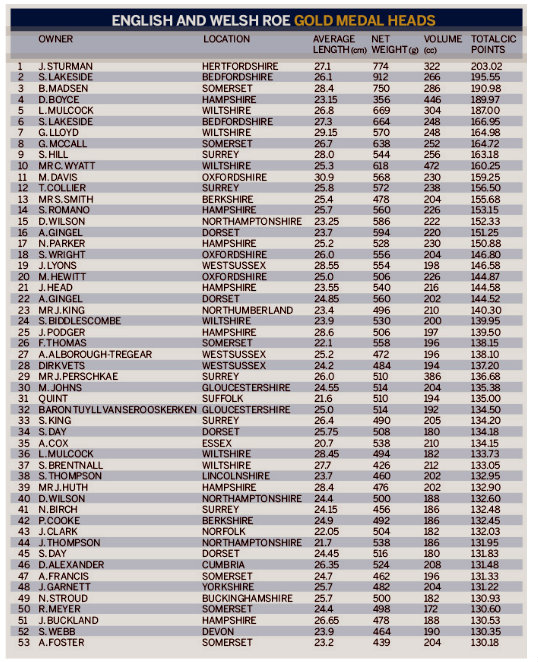Win CENS ProFlex DX5 earplugs worth £1,149 – enter here
English and Welsh roe review 2017 and other species

The CIC’s trophy measuring system has had another good year.
Newly qualified UK measurers got into their stride throughout 2017 at home and at shows around the country. And senior members of the UK Trophy Evaluation Board (TEB) attended the International TEB in Budapest last September to assess, along with other senior international judges, the research project that has led to the reduction in drying-out time before trophies can be measured.
Important in the conclusions of the report was the clear settling of weight at and beyond the 30-day point, making the final discussion a relatively short affair before agreement as to this major change. Equally clear was the fact that, before that 30-day point, weight values could fluctuate unacceptably. This is important because the scoring system, measuring as it does to decimal points, means all measurements must be as accurate as possible, using the most appropriate equipment for the task and ensuring that measurers are all complying with the details of the formulae.
Also of interest was the evidence that other species, where length measurements were a factor, were also affected by this drying-out period, hence the application of the rule to all species.
Training and upgrading courses have taken place across Europe and further afield. In 2017, nine training courses were run in seven countries, qualifying 150 new certified CIC measurers, ensuring a level of qualification and assessment unrivalled in the countries involved. New to the CIC is Argentina, where I was fortunate to experience not only the hospitality of the Argentine hunting fraternity while instructing on the course, but also the hunting of game in the wilds of the north-west, with puma, peccary, brocket and wild bull all on the menu.
All-time record
The year 2017 was also a bumper one for CIC trophy measuring in the UK, with more than 1,000 heads of all species measured and with 853 achieving medal status — an all-time record. Roe was one of the species where we saw a dramatic rise in the number presented for assessment, matched with a rise in quality. The top head from Hertfordshire, presented by Jason Sturman, scored 203.02 CIC points.
We measured 276 roe from England and Wales, 53 of them making gold medals, 82 silver and 84 bronze. This represents a pattern in the proportion of gold, silver and bronze medals that we have seen in previous years.
Twenty-five separate counties produced roe heads that were awarded medals. Another change in the top order occurred this year, with Hampshire providing the lion’s share — 32 heads, of which seven achieved gold medals. Somerset was next with 28 heads, followed by Surrey with 24. Other notable producers of quality medal heads were Wiltshire and Dorset with 16 each, Oxfordshire with 15, Yorkshire with 12 and Sussex with 11.
It is interesting that a number counties achieved at least one gold medal, with Essex, Lincolnshire, Northumberland, Suffolk, Norfolk, Buckinghamshire, Bedfordshire and Northamptonshire adding to the regular producers, and for the first time Hertfordshire, with the best of the year. In terms of success, Wiltshire leads the way with 37 per cent of the heads submitted making gold.
Where to visit the CIC
In 2018, the CIC will be represented at a number of game fairs, hosted at each by the National Gamekeepers’ Organisation.
Quality
Quality within gold-medal heads was well above the previous standard, with three times the number of heads scoring more than 150 CIC points than last year. Of those, five scored over 180 points, each coming from a different county: Lee Mulcock’s 187-point head from Wiltshire, D. Boyce’s 189.97 head from Hampshire, Brian Madsen’s 190.98 head from Somerset and S. Lakeside’s 195.55 head from Bedfordshire could all easily have been top of the year’s pile, but for Mr Sturman’s Hertfordshire buck, weighing in at 774g and with a volume of 322cc, scoring a healthy 203.02 points. Hertfordshire is not well known for its quality roe, but there is no doubting the standard of this animal.

S. Lakeside’s trophy shows a symmetry that typifies the structure of roe deer antlers
The trend towards more well-formed six-pointers with good symmetry, which we identified last year, continues. Mr Sturman’s Hertfordshire head, despite being a seven-pointer, shows a symmetry that typifies the structure of roe antlers. Such applies equally to S. Lakeside’s Bedfordshire head, which again has seven points, but whose overall symmetry is clear.
It is often the case that the larger-scoring heads are less typical of the species than one might expect. The heavier the weight and the larger the volume, the greater the chance that the antlers will be less symmetrical, less well defined and more often less attractive than a smaller head.
An example of this phenomenon is Gary McCall’s Somerset head (164.72), where the slight palmation of the left-hand antler adds to the volume but perhaps not to the beauty. That all said, typical examples of roe are evident in Mickey Davis’s Oxfordshire contender (159.25), Sam Wright’s Oxfordshire one (146.80), and in particular Stephen Hill’s 163.18-point head from Surrey. So symmetry and regularity can be found in high-scoring roe, but the bigger the score and thereby the greater the weight and volume, the greater the chance the head will be less attractive, at least to some, than lower-scoring heads.
Heads measured this year weighed on average 557g for gold, 442g for silver and 403g for bronze. As always, averages tell only part of the picture. With gold medals, the heaviest was 912g and the lightest 426g. The heaviest silver was 518g and the lightest 376g. Bronze highs and lows were 472g and 336g. Interestingly, the highest-scoring head, at 774g, was lower in weight than that which scored in second place, the combination of weight and volume being the deciding factor in the overall score.
To read CIC other species review article click here and for other results click on relevant section below.
Related Articles
Get the latest news delivered direct to your door
Subscribe to Shooting Times & Country
Discover the ultimate companion for field sports enthusiasts with Shooting Times & Country Magazine, the UK’s leading weekly publication that has been at the forefront of shooting culture since 1882. Subscribers gain access to expert tips, comprehensive gear reviews, seasonal advice and a vibrant community of like-minded shooters.
Save on shop price when you subscribe with weekly issues featuring in-depth articles on gundog training, exclusive member offers and access to the digital back issue library. A Shooting Times & Country subscription is more than a magazine, don’t just read about the countryside; immerse yourself in its most authoritative and engaging publication.









